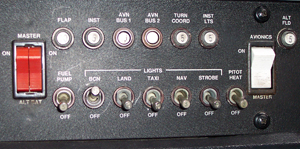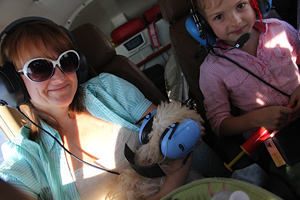When the Successful Outcome of the Flight Is Seriously In Doubt |
||
Any pilot who has taken a check ride – and reviewed the requirements of the Practical Test Standards (PTS) – likely will have seen that among the benchmarks for “Satisfactory Performance” is the requirement that you “demonstrate mastery of the aircraft with the successful outcome of each TASK performed never seriously in doubt.” Emphasis added.  Of course, that is quoted from the old version of the PTS. Now, that very requirement has been incorporated into the new definition of “Single-Pilot Resource Management (SRM)”, which has been included now as a “TASK” in the new versions of the PTS. Specifically, we are told that SRM is, “[T]he art and science of managing all the resources (both onboard the aircraft and from outside sources) available to a single-pilot … to ensure that the successful outcome of the flight is never in doubt.” Emphasis added … again! A while ago, a serendipitous series of events experienced by a friend of mine, a fellow pilot, really got me thinking about that line, especially since so many pilots seem to continue flying long after the successful outcome of the flight should have become “seriously in doubt”. Here’s an odd example from the Northeast, where I teach: “On January 15, 2012, about 1010 eastern standard time, a Piper PA-24-180 [Single Comanche], … crashed into Cape Cod Bay near Brewster, Massachusetts…[A]n instrument flight rules flight plan was filed for the instructional flight from Hyannis, Massachusetts (HYA) to Vineyard Haven, Massachusetts (MVY)…The airplane sustained substantial damage. The certified flight instructor and private pilot were fatally injured. Sadly, the NTSB’s annals are replete with such examples. And before we are too harsh on the pilots involved, I would like to propose we all consider the advice I always give to people who read accident reports: If, magically, we could have handed this accident report to the pilots involved just prior to their departure, they’d have been as aghast as we are at the pilots’ failure to take some more appropriate action after having smoke in the cockpit! I believe this about nearly every accident report I’ve read! Yet airplanes continue to be flown far longer than pragmatically justifiable once some unexpected condition has developed; and thus, long after the successful outcome of the flight has become seriously in doubt! So what happens?I have a theory – pilots fear having an emergency. Not in the sense that the non-flying public think we “fear” emergencies. After all, the majority of a pilot’s training is oriented to equip pilots with the cognitive and physical skills to maintain control of an airplane once a potential crisis has arisen and to prioritize their task load to ensure that the situation doesn’t become worse. No, instead pilots’ “fear” lies in explaining that they’ve had an emergency.
If Confession Is Good for the Soul… I can say that I’ve been there. I’ve had a few unexpected incidents occur during my flying career. I too ended up with a smoke-filled cockpit. Also, I have had an engine shut down in flight. And on yet another occasion, the airplane developed a strange vibration that wasn’t clearly caused by the engine. I was with a student, teaching, when each of these incidents occurred! On the winter night that my plane’s cockpit filled with smoke, I was about 10 to 15 miles southwest of Fitchburg Airport (FIT) in Massachusetts. We had been released from VFR flight following and my student began the before landing checklist. He noted that the landing and taxi light circuit-breaker switches (see photo above) were “very hot” to the touch. Suddenly, the smoky smell in the cockpit intensified. We had been aware of the smell, but we had attributed it to oil burning off the engine – it turns out that, earlier that day, someone had sloppily added oil to the engine and ended up dumping it all over the place. By the time the oil was “cleaned up”, it was too late for them to fly, so my student and I were the first ones to fly the plane following the engine being coated with oil…so yes, we talked ourselves into believing that the situation was fairly benign – simply a combined odor of oil and the aircraft’s heating system. However, when the circuit breaker switches proved too hot to touch, and began tripping off, we knew that we’d misidentified the problem. Since we could not see Fitchburg Airport, I immediately assumed control of the plane, squawked 7700 and turned toward the very long runway at Worcester-Regional Airport in Worcester, Massachusetts (ORH), where I knew emergency services would be readily available. I called Bradley Approach Control and immediately was given an unimaginably high, professional and helpful level of assistance. After landing, we were greeted by the airport’s firefighting rescue squad after shutting down the plane on the runway. We also got to meet the local Worcester Fire Department! Did You have to “call the tower”?I’m sure that is exactly what many of you are wondering…Well, yes, but the reason was they simply wanted to ensure that we were alright. They also passed on the phone number for the Bradley TRACON. There too, the shift supervisor simply wanted to speak to me, only to know that we’d made it down safely. Providing assistance to an aircraft in distress is one major function of our Air Traffic Control (ATC) system! Accordingly, pilots need to stop thinking about ATC as an “us” verses “them” predicament. I assure you, we are all on the same side of this flying endeavor! Everyone wants to see it work safely! I filled out no reports, and was asked only to leave my name and phone number in case any questions arose. Naturally, the local Flight Standards District Office (FSDO) – the local FAA office – was interested in what happened, but again – pilots read this part carefully – it really isn’t us verses them either! The FAA’s interest is in ensuring that if there is some sort of problem with a system or component in an aircraft, it gets resolved before someone else has similar difficulties. Sure, if a pilot misbehaves, the FAA has the authority to investigate and take action, but in an emergency situation, it really isn’t the first thought of the FAA that the pilot has screwed up and needs to be sanctioned! So What About That Friend…
Yes, him! It all started on night flight when he was returning a friend’s airplane back to Hartford-Brainard Airport from Philadelphia, Pennsylvania. He had the friend’s wife, daughter and the family’s newly adopted puppy (yes with the pooch hearing protectors) in the plane because he’d flown down with the friend to drop him off in Philadelphia. After getting a weather update before leaving Philadelphia, and watching the weather on his iPad, my friend got a bit suspicious of the conditions as he was closing in on the last 30 miles of the flight, so he contacted Flight Service. The briefer informed him that the storm cell he’d been watching was moving towards Hartford and he’d likely get there at the same time as it! So, my friend was faced with a choice:
|
||
My friend, who is not instrument rated, didn’t hesitate to divert, which I’m sure most of you would agree is the most prudent course of action. No emergency, no problems, he just told the New York radar controller that he intended to land at Oxford due to weather up ahead of him. My friend solved his problem by avoiding one! He didn’t press on to see if he could make it those last few miles. If he had, it’s likely that, at the very least, he would have encountered an inadvertent flight into Instrument Meteorological Conditions (IMC) as a Visual Flight Rules (VFR) pilot – at night! He DID NOT continue flying until the “successful outcome of the flight was seriously in doubt” and then look for a solution! |
||

|

|

|
But Wait, There’s More…Then, only a short couple of weeks later, my friend was departing Northampton, Massachusetts (7B2) rather late one evening. On climb out, he noted the engine running a bit strangely, and he believed that his climb rate wasn’t what it should be. He wisely elected to head over to Westfield-Barnes (BAF) for a precautionary landing. Good thing too, because it turns out a fuel line to the fuel injected engine was happily disintegrating (yes, that 100 hour airworthiness directive on Lycoming engine fuel injector lines was done about 50 hours earlier; yet, that was his engine’s problem). My friend mitigated this situation and avoided a problem by not being afraid to tell Bradley Approach that he had developed an issue with his engine. He was immediately given all the assistance he needed and the only interaction he had once on the ground was with a Massachusetts Guardsmen who was sent out to be sure they’d landed safely since this predicament arose after the Westfield Tower had closed for the night! Surely Things Improved for Him…Not exactly! Almost as if to prove that my friend has the worst luck possible, about 3 days after the aforementioned “engine problem”, he was with another pilot friend when they struck a seagull on takeoff from an airport in northern Massachusetts! Wisely, he observed to his friend, the pilot flying, that the airplane was still under control, so they flew a standard pattern back to the runway and landed uneventfully! No panic, no problem, just a willingness to ensure that no flight of his ever is continued until the successful outcome is seriously in doubt! For him, there were no bad outcomes other than the fact that we started joking with him that it would be alright if he, someday, returned in the same airplane that he’d departed in! How Can We All Apply This Lesson?My hope is that we all will be like my friend in our decision making, especially because I know we all can make equally good decisions. My hope also is that we all will be equally successful in the outcome of all of our flights! Remember, if you fly long enough, eventually, something will happen during one of your flights! Now, it is all the more likely that you will have the same presence of mind if and when an adverse situation befalls you simply because you have read this! Seriously, all that is necessary is that you consider that there is nothing to “fear” from having an emergency and asking for the help that will be provided by ATC. The only “fear” that any of us should have when flying is the “fear” of continuing a flight until its “successful outcome is seriously in doubt”! |
||
Article by: Terry Keller Jr. |
||
